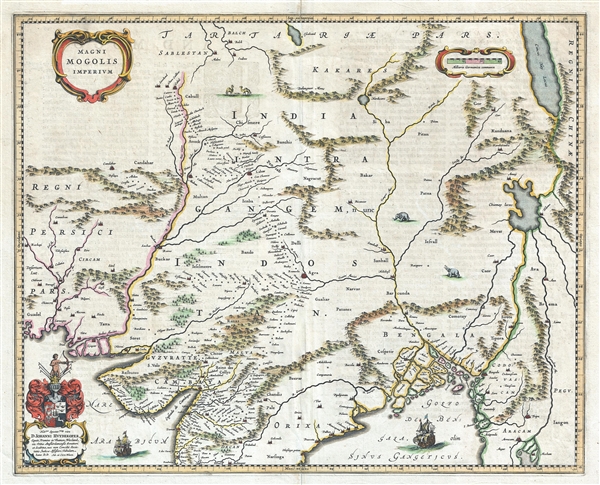
This item below is out of stock, but another example (left) is available. To view the available item, click "Details."
Details
1640 Blaeu Map of Northern India, Nepal, and Pakistan
1640 (undated) $850.00
1640 Blaeu Map of Northern India or the Mogul Empire
MagniMogolisImperium-blaeu-1640
Title
1640 (undated) 16.5 x 20.5 in (41.91 x 52.07 cm) 1 : 6800000
Description
The Empire of the Great Mogul was founded at the outset of the 16th century and extended from present day Afghanistan to Dacca, Bangladesh. The Empire was of great commercial to English and Dutch trading concerns, which doubtless this map is intended to court. Much of the cartography here is based upon the 1618 Willliam Baffin, who in turm received reports from Sir Thomas Roe. Roe was the ambassador of King James I of England the Mogul Emperor Jahangir c. 1615.
Blaeu offers a striking depiction of the apocryphal Lake of Chiamay appears just north of the Bay of Bengal as the source of four important Southeast Asian river systems including the Irrawaddy, the Dharla, the Chao Phraya, and the Brahmaputra. The curious Lake of Chiamay (also called Chiam-may or Chian-may), roughly located in the area of Assam but sometimes as far north as Tibet and China, began to appear in maps of this region as early as the 16th century and persisted well into the mid 18th century. Its origins are unknown but may originate in a lost 16th century geography prepared by the Portuguese scholar Jao de Barros. It was speculated to be the source of five important Southeast Asian River systems and was mentioned in the journals of Sven Hedin, who disputes the notion. There are even records that the King of Siam led an invasionary force to take control of the lake in the 16th century – although this may in fact be a reference to the conquest of Chaing Mai. Nonetheless, the theory of Lake Chiamay was ultimately discredited and largely disappeared from maps entirely by the 1760s.
This map was prepared by Joan and Cornelius Blaeu, sons of Willem Janzoon Blaeu, for publication in the 1640 French edition of the Atlas Maior.
Cartographer
Joan (Johannes) Blaeu (September 23, 1596 - December 21, 1673) was a Dutch cartographer active in the 17th century. Joan was the son of Willem Janszoon Blaeu, founder of the Blaeu firm. Like his father Willem, Johannes was born in Alkmaar, North Holland. He studied Law, attaining a doctorate, before moving to Amsterdam to join the family mapmaking business. In 1633, Willem arranged for Johannes to take over Hessel Gerritsz's position as the official chartmaker of the Dutch East India Company, although little is known of his work for that organization, which was by contract and oath secretive. What is known is his work supplying the fabulously wealthy VOC with charts was exceedingly profitable. Where other cartographers often fell into financial ruin, the Blaeu firm thrived. It was most likely those profits that allowed the firm to publish the Theatrum Orbis Terrarum, sive, Atlas Novus, their most significant and best-known publication. When Willem Blaeu died in 1638, Johannes, along with his brother Cornelius Blaeu (1616 - 1648) took over the management of the Blaeu firm. In 1662, Joan and Cornelius produced a vastly expanded and updated work, the Atlas Maior, whose handful of editions ranged from 9 to an astonishing 12 volumes. Under the brothers' capable management, the firm continued to prosper until the 1672 Great Amsterdam Fire destroyed their offices and most of their printing plates. Johannes Blaeu, witnessing the destruction of his life's work, died in despondence the following year. He is buried in the Dutch Reformist cemetery of Westerkerk. Johannes Blaeu was survived by his son, also Johannes but commonly called Joan II, who inherited the family's VOC contract, for whom he compiled maps until 1712. More by this mapmaker...

